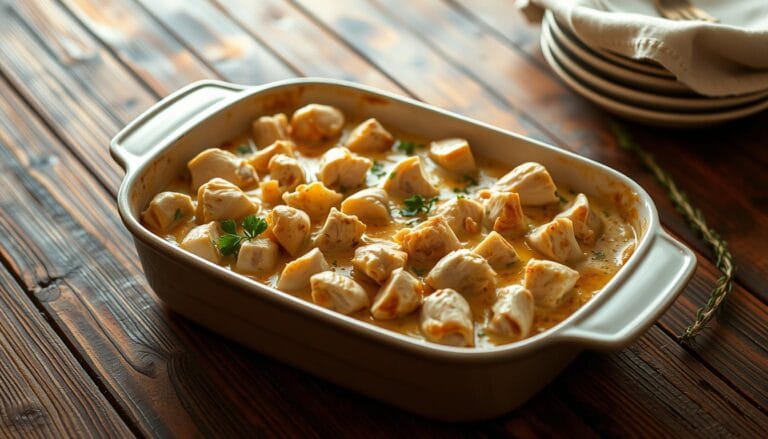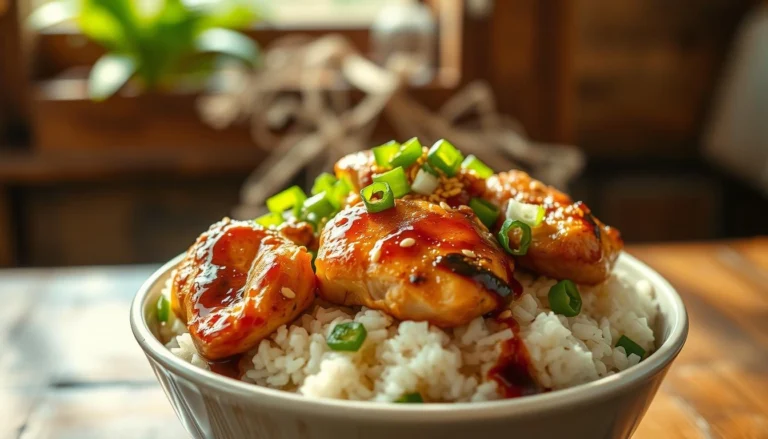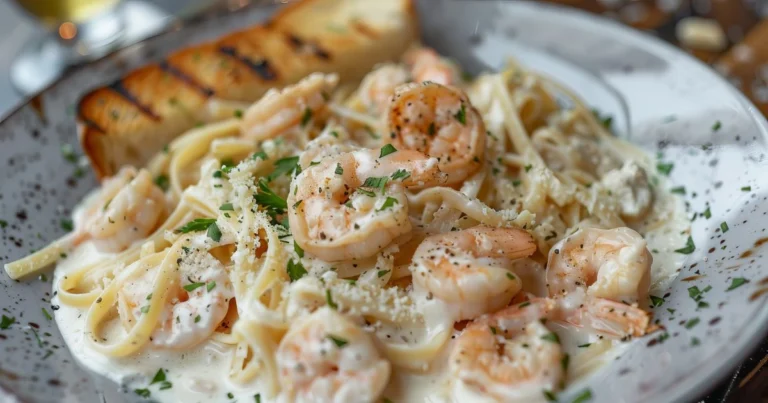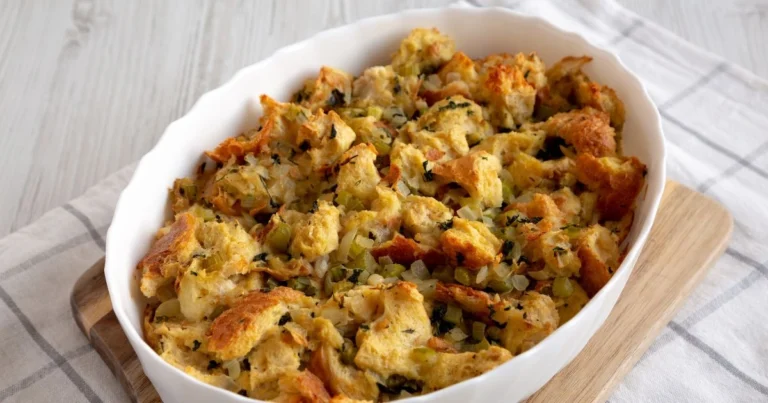Step-by-Step Guide to Cooking Chicken and Shrimp Stir Fry in 25 min

Table of Contents
Imagine a busy weeknight with no time to cook. That’s when chicken and shrimp stir fry saves the day. This quick recipe turns simple ingredients into a gourmet meal in under 30 minutes.
Stir fry is more than just a meal; it’s a flavorful journey. It’s perfect for anyone, whether you’re always on the go or want to impress at home. This dish is your new favorite weeknight fix.
This recipe is easy and flexible. With a few ingredients and basic steps, you’ll make a tasty meal. It’s great for when you’re short on time but want something delicious.
Key Takeaways
- Quick and easy dinner solution in less than 30 minutes
- Versatile recipe that allows for customization
- Balanced nutritional profile with lean proteins
- Perfect for meal prep and busy weeknights
- Restaurant-quality meal prepared at home
Understanding the Origins of Asian Stir-Fry Cuisine
Stir-fry cooking is a key part of Asian culture, especially in Chinese traditions. It turns simple chicken and shrimp dishes into amazing meals. These dishes have won the hearts of food lovers all over the world.
The start of stir-fry dates back to the Han dynasty. This was a crucial time in Chinese cooking history. It was when new cooking ways were born that changed how meals were made.
Traditional Cooking Methods
Stir-fry came from practical needs in Chinese kitchens. Chefs found that cooking at high heat:
- Kept nutrients in food
- Shortened cooking time
- Brought out bright flavors
- Used less fuel
Cultural Significance
In Chinese culture, stir-frying is more than cooking. It stands for:
- Family ties
- Creative cooking
- Smart meal making
Evolution of Stir-Fry Techniques
Stir-fry has changed a lot, from old wok cooking to new beef bacon recipes. Chefs everywhere use this method in many dishes. It shows how stir-fry is loved and used all over the world.
Stir-frying is not just cooking—it’s an art form that connects cultures through flavor and technique.
This method cooks meats and veggies fast. It keeps their texture and nutrients. That’s why it’s loved by both home cooks and professional chefs.
Essential Ingredients for Chicken and Shrimp Stir Fry
Starting a tasty chicken and shrimp stir fry means picking the right ingredients. You’ll choose top-notch proteins and fresh veggies. These will make your dish go from good to great.
For your protein base, you’ll need:
- 1 pound boneless, skinless chicken breast
- 1 pound fresh shrimp, peeled and deveined
- 1/3 cup raw cashews for added crunch
Choosing the right veggies is key for your chicken and shrimp alfredo stir fry. You’ll want a mix that includes:
- 1 head broccoli, cut into small florets
- 1 red bell pepper, thinly sliced
- 8 oz sugar snap peas
- 2 cloves garlic, finely chopped
For cooking beef bacon or other proteins, use oils that don’t burn easily like canola or extra light olive oil. The sauce is what gives your dish its flavor:
- 1/2 cup reduced-sodium soy sauce
- 2 tablespoons honey
- 2 teaspoons toasted sesame oil
- Juice of 1 lime
- Pinch of crushed red pepper flakes
Pro tip: Always use fresh ingredients and cut them into uniform sizes to ensure even cooking and maximum flavor absorption.
Kitchen Equipment and Tools Needed
More than just ingredients are needed for a tasty stir-fry. Your kitchen tools play a big role, especially for bacon wrapped beef or beef bacon appetizers. The right tools help cook evenly and achieve professional results.
Choosing the Right Wok
Finding the perfect wok is key for stir-frying. Carbon steel woks are the best, costing about $65 on average. The Yosukata and Mammafong models are top choices, known for:
- Quick heat distribution
- Minimal food stickage
- Versatile cooking surface
- Lightweight design for easy tossing
Essential Cooking Utensils
Here are the must-haves for your stir-fry toolkit:
- Wok chuan spatula ($30)
- Kitchen tongs ($11-$80)
- Spider strainer ($12)
- Chinese cleaver ($56)
Heat Source Considerations
Stir-frying works differently on different stovetops. Gas ranges are usually the best for wok cooking. Pro tip: Make sure your heat source can get hot fast for that perfect sear.
“The right tools transform home cooking from ordinary to extraordinary.” – Professional Chef
Preparing Your Proteins and Vegetables
Getting your ingredients ready is key to a tasty stir-fry. You need to prepare your proteins and vegetables carefully. This makes sure they cook quickly and evenly.
Begin with your proteins. Cut chicken into 1-inch pieces for even cooking. For shrimp, peel and devein them, keeping tails on for a nice look. You can also add beef bacon bites for extra flavor.
- Chicken: Cut into 1-inch uniform pieces
- Shrimp: Peel, devein, keep tails on
- Optional: Smoked beef bacon for added depth
Vegetables need attention too. Slice red bell peppers, asparagus, and snow peas into the same size. This ensures they cook right and stay tender-crisp.
Pro tip: Mise en place is your secret weapon. Prepare all ingredients before you start cooking to create a smooth, stress-free stir-fry experience.
For better taste, try marinating your proteins. Mix grated ginger, garlic, and low-sodium soy sauce. It makes your dish go from good to great.
Mastering the Art of Stir-Fry Sauce Making
Making the perfect stir-fry sauce can take your cooking to the next level. It’s key for dishes like beef bacon rolls or skewers. The right sauce can make your dish stand out.
Knowing the basic parts of a stir-fry sauce is key. It’s what makes your dish taste like it’s from a restaurant. The main ingredients work together to create a balanced flavor.
Basic Sauce Components
- Soy sauce: 1/4 cup (primary flavor base)
- Water: 1/4 cup (for consistency)
- Honey: 1/4 cup (natural sweetener)
- Corn starch: 4 teaspoons (thickening agent)
- Cold water: 1 tablespoon (for slurry)
Flavor Enhancement Tips
To enhance your sauce, try these tips:
- Aromatics: Add minced garlic or grated ginger
- Incorporate a splash of rice vinegar for tanginess
- Use sesame oil for depth of flavor
- Experiment with chili sauce for heat
Sauce Consistency Guidelines
| Technique | Result |
|---|---|
| Corn starch slurry | Thickens sauce without lumps |
| Boiling before thickening | Ensures smooth, glossy texture |
| Gradual slurry addition | Prevents over-thickening |
The perfect stir-fry sauce balances flavors and consistency. With practice and trying new things, you’ll get better at making your own sauce.
The Perfect Rice and Noodle Accompaniments
Choosing the right rice and noodles can make your stir-fry amazing. Rice is the base of your dish, turning it into a complete meal. For those who love beef bacon wraps, finding the perfect side can make your meal even better.
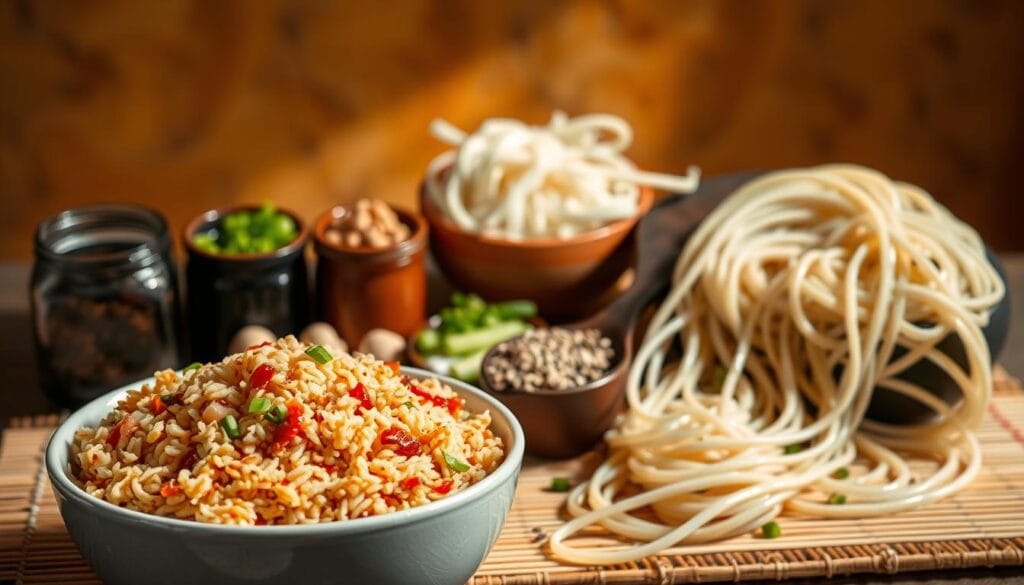
- Jasmine rice – fragrant and light
- Brown rice – nutritious whole grain option
- Basmati rice – aromatic long-grain choice
If you prefer noodles, there are great options for beef bacon meatballs fans. You can try:
- Rice noodles – traditional Asian style
- Soba noodles – buckwheat-based option
- Quinoa – protein-packed alternative
Getting rice just right is key. Use a 2:1 water-to-rice ratio. Let the rice rest for 5-10 minutes after cooking for the best texture.
| Rice Type | Cooking Time | Water Ratio |
|---|---|---|
| Jasmine Rice | 15-18 minutes | 2:1 |
| Brown Rice | 45-50 minutes | 2.5:1 |
| Basmati Rice | 15-20 minutes | 1.5:1 |
Day-old rice is best for stir-fries. It keeps the rice from getting soggy and ensures each grain stays flavorful.
Chicken and Shrimp Stir Fry Cooking Process
Making a great chicken and shrimp stir fry needs careful timing and skill. It’s all about cooking proteins and veggies just right.
Protein Cooking Techniques
Start by cooking your chicken and shrimp with precision. Cook chicken pieces for 2-3 minutes until they’re golden. Then, cook shrimp for 2-3 minutes, until they’re pink and firm.
- Chicken cooking time: 2-3 minutes
- Shrimp cooking time: 2-3 minutes
- Heat setting: High to medium-high
Vegetable Addition Strategy
Adding veggies in the right order is key. Start with hard veggies like carrots and broccoli. Add softer veggies like bell peppers and zucchini last to keep them crisp.
Final Assembly Steps
Finally, mix all ingredients together and add your sauce. Stir quickly to coat everything evenly. This whole process should take about 15 minutes.
| Ingredient | Cooking Time |
|---|---|
| Chicken | 2-3 minutes |
| Shrimp | 2-3 minutes |
| Hard Vegetables | 4-5 minutes |
| Soft Vegetables | 1-2 minutes |
Always keep your ingredients moving and use high heat for the best results.
Common Mistakes to Avoid
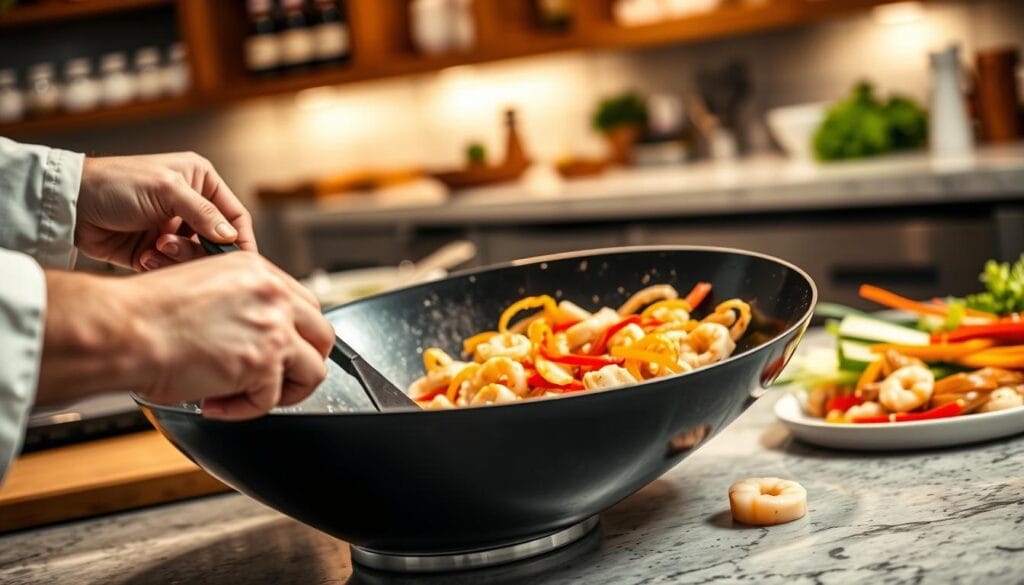
Mastering chicken and shrimp alfredo stir fry is all about avoiding common mistakes. Many home cooks struggle to get the flavor and texture right. Knowing what to avoid can make your cooking much better.
Here are some key errors to watch out for when making easy chicken and shrimp recipes:
- Overcrowding the Pan: Too many ingredients in the pan can make it steam instead of fry. This stops the food from caramelizing and losing flavor.
- Inadequate Wok Preheating: Your wok needs to be very hot before adding food. A cool pan will make your proteins soggy and cook unevenly.
- Improper Ingredient Cutting: If your ingredients are not cut the same size, they won’t cook evenly. Try to cut them all to the same thickness:
- Chicken: ½ inch thick
- Shrimp: Similar sized pieces
- Vegetables: Thin, consistent strips
Timing is key in chicken and shrimp alfredo stir fry. Cook the proteins first, then the vegetables. Take the meats out when they’re 80% done to avoid overcooking. The veggies should stay crisp and colorful.
Pro tip: Use a carbon steel wok for the best heat distribution and a smoky flavor. Always stir the ingredients to prevent burning and ensure even cooking.
Plating and Presentation Techniques
Creating a stunning chicken and shrimp stir fry is more than just cooking. It’s about how you present it. Good presentation turns your meal into a special experience. It makes your dishes unforgettable.
Garnishing Options
Enhance your stir fry with garnishes that look good and taste great. Here are some ideas:
- Freshly chopped green onions for a pop of color
- Toasted sesame seeds for texture and nutty flavor
- Cilantro or Thai basil leaves for aromatic freshness
- Thinly sliced red chili peppers for a vibrant color accent
Serving Suggestions
When serving your stir fry, think about how it looks. Choose plates that match the dish’s colors. White or neutral plates make the ingredients pop.
Color Balance Tips
To make your plate look good, follow these tips:
- Use contrasting colors to make ingredients pop
- Distribute colors evenly across the plate
- Aim for a mix of bright and neutral tones
- Ensure no single color overwhelms the dish
Pro tip: Arrange your chicken and shrimp stir fry with intention, allowing each ingredient to showcase its unique color and texture.
Conclusion
Exploring chicken and shrimp stir fry is more than just learning a recipe. It’s about mastering a versatile cooking method. This method turns simple ingredients into amazing meals.
Stir-frying lets you make dishes that fit your taste and what you have on hand. You can use chicken, shrimp, or even tofu. This way, you keep nutrients high and flavors bright, all in under 45 minutes.
Keep practicing your stir-fry skills. Each meal is a chance to get creative. Try new proteins, veggies, and sauces to find your own style. Your kitchen is ready to make delicious stir-fries that will wow everyone.
Start cooking, stay curious, and enjoy the tasty journey of mastering stir-frying!

